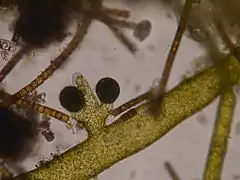Vaucheria litorea
Vaucheria litorea is a species of yellow-green algae (Xanthophyceae).[2] It grows in a filamentous fashion (forming long tubular cells connected end to end).[2] V. litorea is a common intertidal species of coastal brackish waters and salt marshes of the Northern Atlantic, along the coasts of Europe and North America. It is also found in the Eastern Pacific coasts of Washington state. It is found to be able to tolerate a large range of salinities, making it euryhaline.[3]
| Vaucheria litorea | |
|---|---|
 | |
| Scientific classification | |
| Clade: | SAR |
| Phylum: | Ochrophyta |
| Class: | Xanthophyceae |
| Order: | Vaucheriales |
| Family: | Vaucheriaceae |
| Genus: | Vaucheria |
| Species: | V. litorea |
| Binomial name | |
| Vaucheria litorea | |
Like most algae, V. litorea obtains its energy through photosynthesis taking place in chloroplasts. The chloroplasts of V. litorea contain the photosynthetic pigments Chlorophyll a, Chlorophyll c, β-Carotene, and the carotenoid diadinoxanthin.[4]
Vaucheria litorea are consumed by the sea slug Elysia chlorotica, but are only partially digested by them in order to retain the photosynthetic chloroplasts in a process called kleptoplasty. The sea slug feeds on V. litorea, retaining the chloroplasts in storage in cells along the slug's digestive tract.[5][6] The chloroplasts continue to photosynthesize, providing energy to the slug, and contribute to the unusual coloration of the sea slug by their distribution throughout the extensively branched gut.[6]
References
- Searles, Richard B.; Schneider, Craig W. (1991). Seaweeds of the Southeastern United States: Cape Hatteras to Cape Canaveral. Durham, N.C: Duke University Press. ISBN 0-8223-1101-1.
- Guiry, M.D.; Guiry, G.M. (2008). "Vaucheria litorea". AlgaeBase. World-wide electronic publication, National University of Ireland, Galway.
- Christensen, T. (1998). Salinity preference of twenty species of Vaucheria (Tribophyceae). Journal of the Marine Biological Association of the United Kingdom, 68, pp 531-545, doi:10.1017/S0025315400043381
- Stace, Clive A. (1980). Plant Taxonomy and Biosystematics. Cambridge University Press, 1991. ISBN 978-0-521-42785-2.
- Mujer, C.V., Andrews, D.L., Manhart, J.R., Pierce, S.K., & Rumpho, M.E. (1996). Chloroplast genes are expressed during intracellular symbiotic association of Vaucheria litorea plastids with the sea slug Elysia chlorotica. Cell Biology, 93, 12333-12338
- Rumpho-Kennedy, M.E., Tyler, M., Dastoor, F.P., Worful, J., Kozlowski, R., & Tyler, M. (2006). Symbio: a look into the life of a solar-powered sea slug. Retrieved March 18, 2009, from http://sbe.umaine.edu/symbio/index.html Archived 2011-09-18 at the Wayback Machine